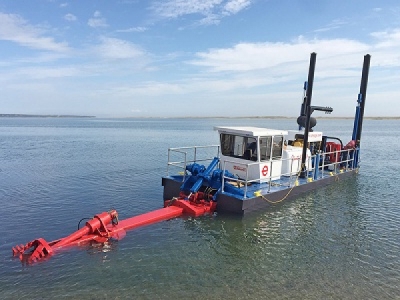
Posted on October 16, 2017
By Kate Shands, MV Times
Edgartown has a new dredge, and it’s almost ready for use. The old dredge was 21 years old and showing serious signs of wear, so Edgartown ordered a new one.
The new dredge came from the Ellicott Company in Baltimore, is 35-feet long, weighs 30 tons, is sparkling white with bright red lettering, blue equipment and yellow cleats, and cost $628,000. It’s equipped with sophisticated computer technology that can measure depths, calculate how much sand is being pumped, and alert the dredge operator when he approaches the boundaries of the dredge area.
The dredge was transported from Baltimore on a flatbed tractor-trailer that was loaded onto a Packer barge in New Bedford, along with a huge crane and the crane’s supply truck, and they all arrived in Vineyard Haven on last Thursday afternoon.
Alerted to its arrival and launch plans, my husband and I decided to see what the launch of a dredge involved. We rose at first light on Friday morning and headed to R.M. Packer, where the barge was docked. Ralph Packer was waiting with a number of workmen and two of the truck drivers as we arrived. He looked at us quizzically but graciously introduced himself and filled us in on what was happening. The two truck drivers had arrived on the Patriot’s early run, but the crane operator, who had not gotten the message about taking the Patriot, had taken the 6 am ferry from Woods Hole. His later arrival meant that the tide had risen, the barge was now higher than the dock, and the truck with the dredge could not drive off the barge. Pulling the two other trucks forward to weigh down the front of the barge didn’t work, so the truck with the dredge had to be towed off the barge by a front loader. Once off the barge, the dredge truck headed out, over the Lagoon drawbridge, to make its way via Meetinghouse Road to Katama Bay. We said goodbye and thank you to Mr. Packer who said, “Glad to have you. Not many people stop by to see what we do.”
We grabbed coffee and muffins from the Black Dog and made our way to the Right Fork in Katama to greet the dredge truck and our daughter, Juliet Mulinare, the administrator of the dredge committee. The truck made a tight left turn onto Atlantic Avenue and continued on to Katama landing, where it backed into the parking lot with the sound of squealing metal as it made an even tighter turn. At the launch site, Juliet introduced us to the dredge group: Ed Handy, chairman of the dredge committee; Greg Bettencourt, foreman; Donny Benefit, dredge operator; Peter Jackson, dredge crew, and Mark DeFeo, consultant.
Along with the dredge group and curious passersby, we watched the crane operator and the driver of the supply truck deploy the crane’s outriggers for stability, put floats under them to help disperse the weight of the load, and load extra weights onto the crane to counteract the weight of the dredge. While we waited, we got explanations of crane and dredge operations and trailer-driving tips. Once the crane was stabilized, the crane operator began lifting the spuds (the metal columns that anchor the dredge in place when it’s pumping sand) off the dredge truck and laying them on the ground. The supply truck driver attached chains to the dredge itself and the crane gently lifted the dredge off the trailer and onto 6×6’s laid out in the parking lot. A fuel truck arrived and put 700 gallons of gas into one of the two gas tanks on the dredge. (The total capacity of the two gas tanks on the dredge is 1,400 gallons, but the crane can’t lift that much weight.) And then the crane lifted the dredge up and into the water.
Once in the water, the dredge tilted noticeably to one side because of the weight of the gas in the single tank. That made placing the first spud into its cage on the stern of the dredge exceedingly difficult; because the dredge was brand-new, the clearances were much tighter than on the old dredge. It took more than an hour of moving the dredge around with its Carolina skiff, trying to get the port spud in place, and success was achieved only by placing a chain around the spud under the water and pulling it so that the tilt of the spud matched the tilt of the dredge. After the port spud was finally placed, the dredge could be stabilized, and it took only five to 10 minutes to place the starboard spud. At that point, it was 2:35 in the afternoon, and the drivers of the crane and its supply truck quickly packed up and left to meet the dredge truck, which had picked up the old dredge, so that all of them could be loaded onto the barge. The barge would return to New Bedford to unload all the trucks, and the drivers, who are not allowed on the barge, were hoping to make a 5 pm ferry.
Source: MV Times





